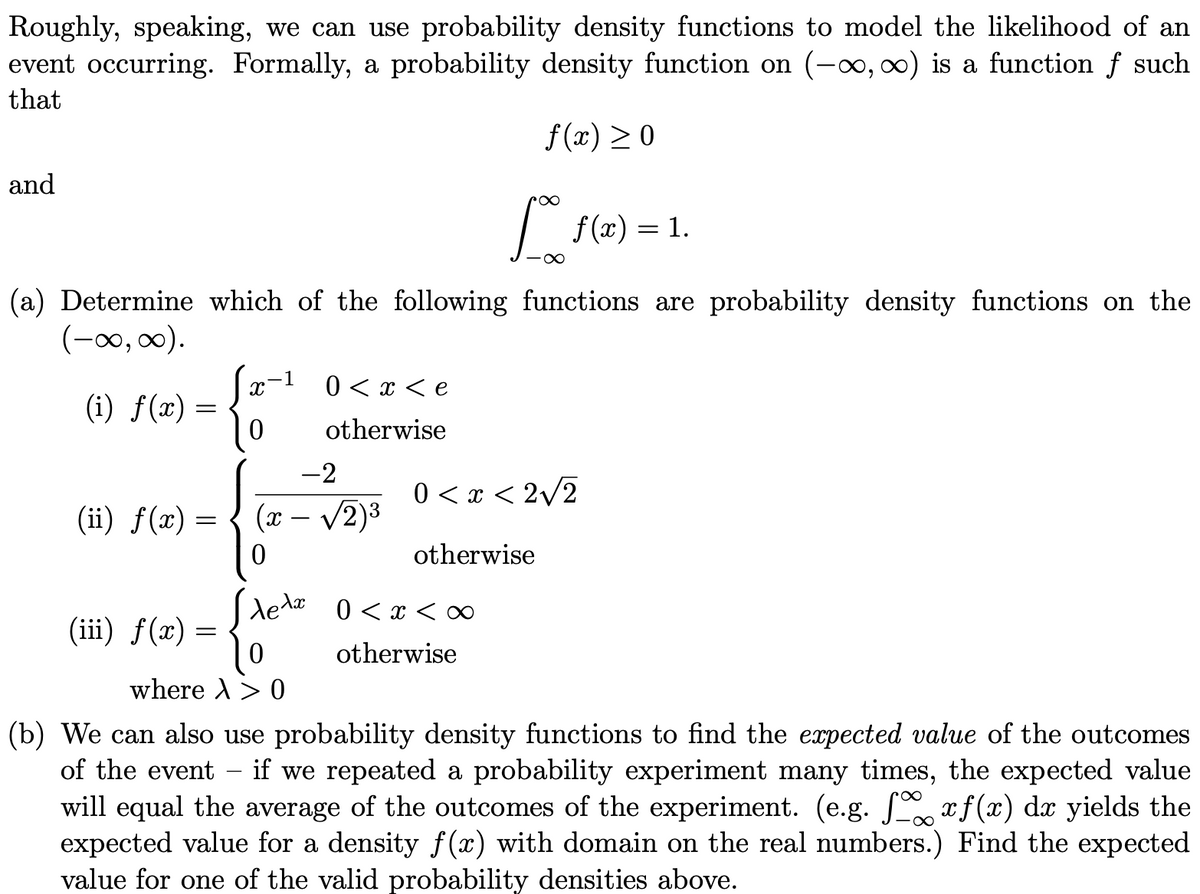Roughly, speaking, we can use probability density functions to model the likelihood of an event occurring. Formally, a probability density function on (-0, 00) is a function f such that f (x) > 0 and roo | f(x) = 1. (a) Determine which of the following functions are probability density functions on the (-∞, 00). 0 < x < e (i) f(x) = otherwise -2 0 < x < 2/2 (ii) ƒ(x) = (x – v2)3 otherwise Aeda 0< x < ∞ (iii) f(x) = otherwise where A> 0
Roughly, speaking, we can use probability density functions to model the likelihood of an event occurring. Formally, a probability density function on (-0, 00) is a function f such that f (x) > 0 and roo | f(x) = 1. (a) Determine which of the following functions are probability density functions on the (-∞, 00). 0 < x < e (i) f(x) = otherwise -2 0 < x < 2/2 (ii) ƒ(x) = (x – v2)3 otherwise Aeda 0< x < ∞ (iii) f(x) = otherwise where A> 0
Calculus: Early Transcendentals
8th Edition
ISBN:9781285741550
Author:James Stewart
Publisher:James Stewart
Chapter1: Functions And Models
Section: Chapter Questions
Problem 1RCC: (a) What is a function? What are its domain and range? (b) What is the graph of a function? (c) How...
Related questions
Question

Transcribed Image Text:Roughly, speaking, we can use probability density functions to model the likelihood of an
event occurring. Formally, a probability density function on (-∞,00) is a function f such
that
f(x) > 0
and
| f(x) = 1.
(a) Determine which of the following functions are probability density functions on the
(-00, 0).
-1
0 < x < e
(i) f(x) =
otherwise
-2
0 < x < 2/2
(ii) ƒ(x) =
(x – /2)3
otherwise
ela 0 < x < ∞
(iii) f(x) = -
otherwise
where A> 0
(b) We can also use probability density functions to find the expected value of the outcomes
of the event - if we repeated a probability experiment many times, the expected value
will equal the average of the outcomes of the experiment. (e.g. , xf (x) dx yields the
expected value for a density f(x) with domain on the real numbers.) Find the expected
value for one of the valid probability densities above.
Expert Solution
This question has been solved!
Explore an expertly crafted, step-by-step solution for a thorough understanding of key concepts.
Step by step
Solved in 2 steps with 2 images

Recommended textbooks for you

Calculus: Early Transcendentals
Calculus
ISBN:
9781285741550
Author:
James Stewart
Publisher:
Cengage Learning

Thomas' Calculus (14th Edition)
Calculus
ISBN:
9780134438986
Author:
Joel R. Hass, Christopher E. Heil, Maurice D. Weir
Publisher:
PEARSON

Calculus: Early Transcendentals (3rd Edition)
Calculus
ISBN:
9780134763644
Author:
William L. Briggs, Lyle Cochran, Bernard Gillett, Eric Schulz
Publisher:
PEARSON

Calculus: Early Transcendentals
Calculus
ISBN:
9781285741550
Author:
James Stewart
Publisher:
Cengage Learning

Thomas' Calculus (14th Edition)
Calculus
ISBN:
9780134438986
Author:
Joel R. Hass, Christopher E. Heil, Maurice D. Weir
Publisher:
PEARSON

Calculus: Early Transcendentals (3rd Edition)
Calculus
ISBN:
9780134763644
Author:
William L. Briggs, Lyle Cochran, Bernard Gillett, Eric Schulz
Publisher:
PEARSON

Calculus: Early Transcendentals
Calculus
ISBN:
9781319050740
Author:
Jon Rogawski, Colin Adams, Robert Franzosa
Publisher:
W. H. Freeman


Calculus: Early Transcendental Functions
Calculus
ISBN:
9781337552516
Author:
Ron Larson, Bruce H. Edwards
Publisher:
Cengage Learning